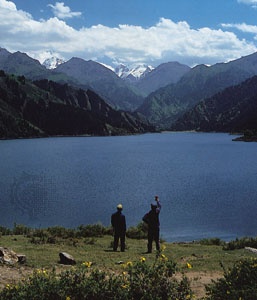Ürümqi
China
Introduction
Chinese (Pinyin) Wulumuqi, (Wade-Giles romanization) Wu-lu-mu-ch'i, Uighur Ürümchi, also spelled Urumqi or Urumchi
 city and capital of the Uygur Autonomous Region of Xinjiang (Sinkiang, Uygur Autonomous Region of), northwestern China. The city (whose name in Uighur means “Fine Pasture”) is situated in a fertile belt of oases along the northern slope of the eastern Tien (Tian) Shan (Tien Shan) range. Ürümqi commands the northern end of a gap leading from the Tarim Basin into the Junggar (Dzungarian) Basin (Junggar Basin). Pop. (2002 est.) city, 1,401,990; (2007 est.) urban agglom., 2,151,000.
city and capital of the Uygur Autonomous Region of Xinjiang (Sinkiang, Uygur Autonomous Region of), northwestern China. The city (whose name in Uighur means “Fine Pasture”) is situated in a fertile belt of oases along the northern slope of the eastern Tien (Tian) Shan (Tien Shan) range. Ürümqi commands the northern end of a gap leading from the Tarim Basin into the Junggar (Dzungarian) Basin (Junggar Basin). Pop. (2002 est.) city, 1,401,990; (2007 est.) urban agglom., 2,151,000.History
The area first came under full Chinese control in the 7th and 8th centuries, when the Chinese established the protectorate general of Beiting some 80 miles (130 km) to the east. A county named Luntai had earlier been founded at Ürümqi in 640, which became an important centre for caravans traveling into the Ili River valley from the main route across Turkistan. After the withdrawal of the Tang dynasty (618–907) from the area in the 750s, Ürümqi came under the control of the Uighurs. It again came under Chinese rule during the campaigns of the Qing dynasty against the Dzungars in the 18th century. In 1760 military colonies were established in the surrounding oases, and in 1763 a Chinese city called Dihua was founded there.
The city became an important Manchu garrison for northwestern China. When the Muslim Rebellion broke out in Xinjiang in the 1860s, Ürümqi was taken by the rebels in 1864 but was eventually recaptured in 1876 by Qing forces under Zuo Zongtang. When the province of Xinjiang was set up in 1884, Ürümqi (Dihua) became its capital. It grew rapidly into the greatest city and centre of trade in Central Asia. Its commercial importance was matched in the last days of the Qing dynasty (1644–1911/12) by its growing strategic and international significance as the British and Russians each attempted to establish influence in Xinjiang.
The contemporary city
Since 1949 Ürümqi has been developed not only as the regional capital and cultural centre of Xinjiang but also as a major industrial base. In addition, efforts have been made to extend the irrigated farmlands in the vicinity (along the foot of the Tien Shan) and to improve the region's agricultural productivity by mechanization. Ürümqi's prosperity has come largely from its mineral resources. In 1955 a large petroleum field was discovered at Karamay, to the north in the Junggar Basin; it was brought into production in 1958–59 and has since become one of China's major domestic sources of oil. Extensive coal deposits were found along the foot of the Tien Shan, and there are major mining centres near Ürümqi and at Liudaowan. A large thermal-power station, ironworks and steelworks, an engineering sector (producing agricultural machinery), a cement works, chemical and fertilizer plants, an oil refinery, and cotton-textile mills have been built. Southeast of Ürümqi, in Chaiwopu, is a large windmill power station, the first of its kind in China.
A railway extending northwestward from Lanzhou (Gansu province) that links Ürümqi to the Chinese rail network was completed in the early 1960s. A highway was built following the same route, and other highways have been built across the Junggar and Tarim basins, greatly improving Ürümqi's communications. The rail line has been extended northwestward from Ürümqi to the Dzungarian (Junggar) Gate (Chinese: Alataw Shankou)—a pass through the Zhongghar Alataū (Alataw) Mountains into Kazakhstan. Another rail line, completed in 1999, follows the route of the ancient Silk Road along the northern edge of the Tarim Basin and gives the city convenient access to Kashgar (Kashi), in southwestern Xinjiang. The city's international airport is just to the northwest. The great expansion of and improvements in Ürümqi's transportation infrastructure have transformed the city into a major communications centre for northwestern China.
Ürümqi remains a Uighur city, with Uighur as its chief language; most Uighurs are Muslim. There are Kazakh, Dungan, and Manchu minorities. Much effort has been devoted to building a Uighur cultural base. The city has many schools and institutes of higher education, including several universities, colleges offering special courses for minorities, and institutions for studying medicine, agricultural science, and the Russian language. Notable among these is Xinjiang University, founded in 1924 and reorganized in 2000 following its merger with Xinjiang Engineering Institute. Tian Lake, formed in a crater of the Bogd Mountains (the eastern extension of the Tien Shan) about 70 miles (110 km) east of Ürümqi, is a scenic spot and popular tourist destination.